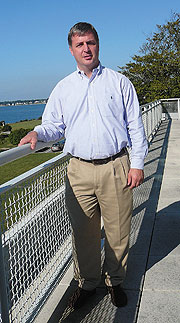  |
| HOME | THIS ISSUE | CALENDAR | GRANTS | BACK ISSUES | < BACK | NEXT > |
Sea Grant links academic expertise with local communitiesby Peg Van Patten - November 5, 2007 | ||||
| When lobsters in Long Island Sound died off in massive numbers in 1999, lobstermen looked to Connecticut Sea Grant and its New York counterpart for help. Over the next few years, the Long Island Sound Lobster Research Initiative – 21 separate research projects coordinated by Sea Grant and the lobster industry – found some answers. It identified the impacts of natural and human environmental stressors on the lobster stock and provided lobster biologists and resource managers extensive new information. Many former lobster fishermen are now successfully growing hard clams for market. And new species, such as razor clams, have been grown experimentally and tested for market feasibility. Connecticut Sea Grant has also worked with shellfish growers and state agencies to speed up the permitting process for growing shellfish. Extension educator Tessa Getchis, Connecticut Sea Grant’s aquaculture expert, served as a liaison between representatives of the shellfish industry and several state and federal agencies. The new process, outlined in a guide soon to be released, greatly reduces the time it takes to obtain a permit. Connecticut Sea Grant is part of a national network of 32 Sea Grant College Programs, administered through the National Oceanic and Atmospheric Administration, based at top research universities in a federal-state partnership. UConn was designated as the state’s Sea Grant College in 1988. Each program conducts scientific research, education, and outreach projects to foster science-based decisions about the conservation and use of marine and aquatic resources. Connecticut Sea Grant supports a range of applied research, education, and extension activities at various institutions, generally universities and colleges, but some times also a museum or aquarium, for example, that has a research component. Either the institution must be Connecticut-based or the research must apply to Connecticut issues or resources. Applied projects with clear relevance to Connecticut’s marine and coastal resources are given priority and are selected via a competitive review process. For example, Nancy Balcom, Connecticut Sea Grant’s extension leader, is leading the development of a management plan for aquatic invasive species in Long Island Sound. The plan incorporates the results of various Sea Grant-sponsored research projects carried out by UConn faculty. These include research progress by marine sciences professor Robert Whitlatch, Charles Yarish, professor of ecology and evolutionary biology, and Senjie Lin, associate professor of marine sciences, on the ecological impacts of a recently introduced invasive alga Grateloupia. Another project, led by Whitlatch, is examining the contribution of private boats to the problem through a phenomenon known as hull-fouling. And Kari Heinonen, a Ph.D. candidate in marine sciences, has performed risk analyses on a number of aquatic animal species with the potential to invade the Sound. “Core NOAA federal and matching funds for Connecticut Sea Grant are expected to total over $1.5 million for the coming fiscal year,” says Rob Johnston, associate director of Connecticut Sea Grant.
“These core funds provide approximately one-third of the combined support for Connecticut Sea Grant programs and activities. The remaining two-thirds originates from sources such as federal, state, and private foundation grants awarded to Connecticut Sea Grant personnel or researchers.” Connecticut Sea Grant emphasizes linking academic expertise with the local community, and has recently strengthened its efforts to connect with stakeholders, including coastal communities, industries, citizen groups, and educators. The program also has an education component that helps K-12 teachers align their course material with state science content standards, and offers educators professional development opportunities and resources. Its communications office produces Wrack Lines, a magazine that brings coastal science and issues to the public. After meeting with citizen and industry groups that benefit from coastal resources, the program developed a new Strategic Plan for 2007-2011 with a vision of fostering sustainable use and conservation of coastal and marine resources. Sylvain De Guise, who became the program’s permanent director last January, says, “One of the most important procedures in creating the new plan was to gather ‘bottom-up’ support and input for the plan. We incorporated broad and diverse input not only from our entire staff, but also from outside the program.” De Guise, a veterinary pathobiologist, was one of the key researchers funded by Sea Grant in the lobster health investigation. When he became director, he was already familiar with the program. Still, he says, as he learned more about Sea Grant, he was impressed by the extent of the program’s impact on society, the economy, and the environment. “Because we are not a regulatory agency, we are seen as an honest broker to whom industry and communities can go for assistance,” he says. De Guise notes that Sea Grant is service-oriented: “We serve as the link to bring a broad range of services from big agencies in Washington, D.C., to local communities, ranging from concerns about sea level, fisheries, pollutants, to marine ecosystems.” Earlier this year, Connecticut Sea Grant earned Category 1 rating from the National Sea Grant Office, following a five-year evaluation. In the report, the program was commended for outstanding work and for leadership at the state, national, and international levels. Gregory Anderson, vice provost for research and graduate education, says the University is proud of the Sea Grant program’s top ranking: “This external recognition of the program’s strengths is a validation of its excellence in a range of activities.” As a result of the ranking, Connecticut Sea Grant will receive an increase in federal funding of $45,000 for 2008 and again in 2009. For more information about Connecticut Sea Grant, visit the program’s web site: http://www.seagrant.uconn.edu. A 52-page report documenting the program’s five-year accomplishments and impacts, “Connecticut Sea Grant Making a Difference,” can be obtained from the Sea Grant Office or on the Web. |
| ADVANCE HOME UCONN HOME |

